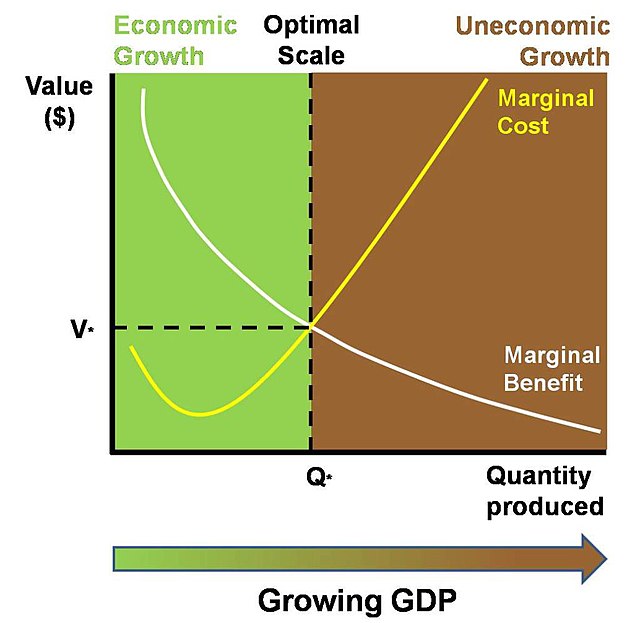Ecological economics, bioeconomics, ecolonomy, eco-economics, or ecol-econ is both a transdisciplinary and an interdisciplinary field of academic research addressing the interdependence and coevolution of human economies and natural ecosystems, both intertemporally and spatially. By treating the economy as a subsystem of Earth's larger ecosystem, and by emphasizing the preservation of natural capital, the field of ecological economics is differentiated from environmental economics, which is the mainstream economic analysis of the environment. One survey of German economists found that ecological and environmental economics are different schools of economic thought, with ecological economists emphasizing strong sustainability and rejecting the proposition that physical (human-made) capital can substitute for natural capital.
The marginal costs of a growing economy may gradually exceed the marginal benefits, however measured.
Exergy analysis can be performed to find connections between economic value and the physical world. Here the costs of heating (vertical axis) are compared with the exergy content of different energy carriers (horizontal axis). Red dots and trend line indicate energy prices for consumers, blue dots and trend line indicate total price for consumers including capital expenditure for the heating system. Energy carriers included are district heating (D), ground-source heat pump (G), exhaust air heat pump (A), bioenergy meaning firewood (B), heating oil (O) and direct electric heating (E).
Natural capital is the world's stock of natural resources, which includes geology, soils, air, water and all living organisms. Some natural capital assets provide people with free goods and services, often called ecosystem services. All of these underpin our economy and society, and thus make human life possible.
Mangrove swamp at Iriomote Island, Japan, providing beneficial services of sediment accumulation, coastal protection, nursery and fish-spawning grounds which may in turn support coastal fishing communities. At least 35% of the world's stock of mangrove swamps has been destroyed in just 20 years
Honeybee (Apis mellifera) pollinating an Avocado crop. Healthy stocks of wild and cultivated pollinator species are important to support the farming industry and help ensure food security.
Aerial view of the Amazon Rainforest. Looked at as a natural capital asset, rainforests provide air and water regulation services, potential sources of new medicines and natural carbon sequestration.
Fires along the Rio Xingu, Brazil – NASA Earth Observatory. Loss of natural capital assets may have significant impact on local and global economies, as well as on the climate.






